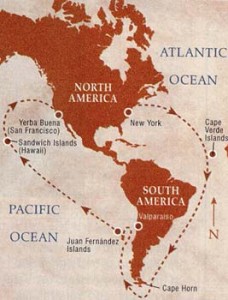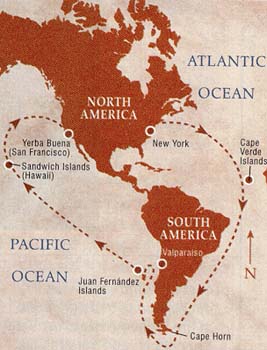While most Mormon pioneers travelled by foot and wagon across the United States, and later by rail when the railroad was completed, there were a few Saints who sailed from the East Coast to the West Coast of the United States. One of the most famous of these groups was the group that travelled on the Brooklyn from New York to San Francisco. The Brooklyn carried a total of 238 passengers on its voyage which departed on February 4, 1846: 70 men, 68 women, and 100 children. Most of the 238 passengers were Mormon, but a few were just general passengers.

Route of the Brooklyn
The Saints who travelled on this ship did so in response to a call from Elder Orson Pratt, who was the presiding apostle of The Church of Jesus Christ of Latter-day Saints in the eastern states, when he heard the Mormons were to leave Nauvoo, Illinois. The Saints were put under the direction of Samuel Brannon, who was the publisher of the Mormon paper The Prophet. Most of the Saints who went along were farmers and mechanics. They took with them all the tools they would need to build a new colony from scratch. They also brought the printing press used for The Prophet as well as a 179-volume collection of books.
The 177-day and 24,000-mile voyage encountered many exciting events. One major storm in the Atlantic Ocean started them off on their journey after only four days at sea, which was followed by another when they reached the Pacific Ocean. In between, they were stuck in calm waters for several days. One passenger, Augusta Joyce Corcheron, described these experiences as follows:
As for the pleasure of the trip, we met disappointment, for we once lay becalmed in the tropics, and at another time we were “hatched below” during a terrific storm. Women and children were at night lashed to their berths, for in no other way could they keep in. Furniture rolled back and forth endangering limb and life. The waves swept the deck and even reached the stateroom. . . . Children’s voices were crying in the darkness, mother’s voices soothing or scolding, men’s voices rising above the others, all mingled with the distressing groans and cries of the sick for help, and, above all, the roaring of the wind and howling of the tempest made a scene and feeling indescribable.
Captain Abel W. Richardson called the Atlantic storm the worst he had ever seen. He was convinced the ship was going to go down, but when he went below deck to inform his passengers of the situation, he met their faith. One woman said, “We were sent to California and we shall get there.”
A total of eleven passengers died on the voyage, mainly due to scarlet fever, consumption (tuberculosis), diarrhea, and dehydration. Laura Goodwin, who died due to a fall during the Pacific storm, was buried in a cave during the stop at Juan Fernandez Island, while the other ten were buried at sea. The ship had been headed for Valparaiso, Chile, and the storm they hit blew them nearly all the way back to Cape Horn. This was a blessing in disguise, because the Saints were able to bathe, do laundry, obtain fresh fruit and potatoes, catch and salt fish, get general supplies, and obtain 18,000 gallons of fresh water. If they had done this at Valparaiso it would have cost them hundreds of dollars, whereas they were able gather most things themselves on the island which inspired Robin Crusoe.
Arriving in Yerba Buena, later renamed San Francisco, on July 31, 1846, the Saints discovered that the United States had taken over the village only three weeks earlier. The Saints were forced to remain in that area until the main body of the Saints decided where to settle, ultimately the Salt Lake Valley, in 1847. The group founded New Hope 70 miles east of Yerba Buena. Six months after their arrival, the Saints were joined by several members of the Mormon Battalion. Only about one-third of the original Brooklyn Saints joined the Saints in Utah after they settled there.
The Brooklyn Saints brought much to the San Francisco area, including the first public school, bank, newspaper, post office, and library. They also brought and grew the first wheat in the area. By 1847, there were more than 500 Saints in California and San Francisco’s population was predominantly Mormon. The efforts and sacrifices made by the Brooklyn Saints helped them to reap many blessings which not only helped New Hope grow, but which helped the Church grow and gain a foundation in new colonies as well.
Sources:
Ships, Saints, and Mariners: A Maritime Encyclopedia of Mormon Migration, 1830–1890. Conway B. Sonne. p. 32–34.
“Voyage of the Brooklyn.” Joan S. Hamblin. Ensign. July 1997. p. 16.
Twitter •


 Watch a video about the restoration of the gospel on lds.org
Watch a video about the restoration of the gospel on lds.org
Would like information: In August 1868 about 1,250 individuals were transported by wagon trains from Laramie, Wyoming–many were from Sweden and Norway–to the Salt Lake Valley.It was reported that they had come by the “Minnesota” and “John Bright.” It is assumed that “Minnesota” and “John Bright” were boats or vessels, or were there other modes of transportation across the plains in 1868 to Laramie. My great grandfather, Horton David Haight was the captain of a company of 46 wagons bringing freight and passengers from the outfitting post at Laramie, Wyoming.